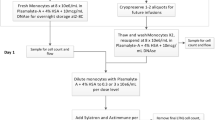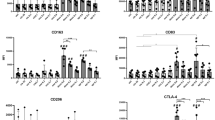Summary
Human blood monocytes (Mo) and monocyte-derived macrophages (Mψ) possess cytotoxic effects against tumor cell lines when appropriately stimulated by various biological response modifiers, e.g., gamma interferon (γIFN) and muramyltripeptide (MTP). Activated Mo/Mψ represent a new tool for the treatment of human malignancies, termed “adoptive cellular immunotherapy”. Activated Mo/Mψ express tissue factor procoagulant activity (PCA), which is a physiological trigger of blood coagulation. PCA was evaluated in vitro using a modification of the one-stage recalcification clotting time, and hemostatic changes were studied in vivo in cancer patients. Nine patients with peritoneal carcinomatosis were injected intraperitoneally with activated Mo and 11 patients with non-small cell lung carcinomas were infused intravenously with activated Mψ. Hemostatic changes were followed using activated partial thromboplastin time (APTT), prothrombin time (PT), thrombin time (TT), fibrinogen level, antithrombin HI (ATIII) and protein C (PC) activities. Fibrinolytic activity was estimated by euglobulin lysis time and assays for plasminogen and fibrin/fibrinogen degradation products (FDP). These assays were performed before and after each autologous infusion and on days 2 and 3. Activated Mo and Mψ expressed potent PCA (85.5±7.5 U/ml for MTP activated Mo and 50±5.3 U/ml for γIFN activated Mψ suspensions). In both groups of patients, APTT, PT, and TT underwent no significant variations. There was no significant consumption of ATIII or PC, and fibrinolysis was not activated during the study period. In the group injected intraperitoneally with MTP-activated Mo, fibrinogen showed a significant and progressive increase in relation to the development of an inflammatory reaction, reaching a maximum average value of 6.1 g/l at the end of the therapy with a concomitant increase in FDP levels. This increase was not observed after intravenous therapy with γIFN-activated Mψ. No patient suffered from hemorrhagic or thrombotic events. In our experience, repeated injections of activated Mo or Mψ expressing potent tissue factor PCA did not induce significant in vivo activation of the coagulation system in cancer patients.
Similar content being viewed by others
References
Caen J, Larrieu MJ, Samama M (1975) L'hémostase, méthodes d'exploration et diagnostic pratique, 2nd edn. Expansion Scientifique FranÇaise, Paris
Edwards RL, Rickles FR (1984) Macrophage procoagulant. Prog Hemost Thromb 7: 183–209
Faradji A, Bohbot A, Schmitt-Goguel M, Dumont S, Eischen A, Wiesel ML, Stierlé A, Folléa G, Eber M, Bergerat JP, Bartholeyns J, Poindron, Witz JP, Frost H, Oberling F (1991) Apheresis-elutriation program for adoptive immunotherapy with autologous activated monocytes in cancer patients. Int J Artif Organs 14: 304–312
Faradji A, Bohbot A, Frost H, Schmitt-Goguel M, Siffert JC, Dufour P, Eber M, Lallot C, Wiesel ML, Bergerat JP, Oberling F (1991) Phase-I study of liposomal MTP-PE-activated autologous monocytes administered intraperitoneally to patients with peritoneal carcinomatosis. J Clin Oncol 9: 1251–1260
Faradji A, Bohbot A, Schmitt-Goguel M, Roeslin N, Dumont S, Wiesel ML, Lallot C, Eber M, Bartholeyns J, Poindron P, Morand G, Witz JP, Oberling F (1991) Phase-I trial of intravenous infusion of ex-vivo activated autologous blood-derived macrophages in patients with non-small cell lung cancer: toxicity and immunomodulatory effects. Cancer Immunol Immunother 33: 319–326
Hanagan JR, Trunet P, Lesher D, Andrejcio K, Frost H (1989) Phase-I development of CGP 19835 A lipid (MTP-PE encapsulated in liposomes). In: Lopez-Berestein G, Fidler IJ (eds) Liposomes in therapy of infectious diseases and cancer. Alan Liss, New York, pp 305–315
Kleinerman ES, Erickson KL, Schroit AJ, Fogler WE, Fidler IJ (1983) Activation of tumoricidal properties in human blood monocytes by liposomes containing lipophilic muramyltripeptide. Cancer Res 43: 2010–2014
Le J, Prensky W, Yip YK, Chang, Hoffman T, Stevenson HC, Balazs I, Sadlik JR, Vilcek J (1983) Activation of human monocyte cytotoxicity by natural and recombinant immune interferon. J Immunol 131: 2821–2826
Levy GA, Edgington TS (1980) Lymphocyte cooperation is required for amplification of macrophage procoagulant activity. J Exp Med 151: 1232–1244
Lyberg T, Baldal KS, Evenson SA, Prydz H (1983) Cellular cooperation in endothelial cell thromboplastin synthesis. Br J Haematol 53: 85–95
Niemetz J (1972) Coagulant activity of leukocytes. Tissue factor activity. J Clin Invest 51: 307–313
Osterud B, Rapaport SI (1977) Activation of the factor IX by the reaction products of tissue factor and factor VII: additional pathway for initiating blood coagulation. Proc Natl Acad Sci USA 74: 5260–5264
Rinehart JJ, Lange P, Gormus BJ, Kaplan ME (1978) Human monocyte-induced tumor cell cytotoxicity. Blood 52: 211–220
Saiki I, Sone S, Fogler WE, Kleinerman ES, Lopez-Berestein G, Fidler IJ (1985) Synergism between human recombinant gamma-interferon and muramyldipeptide encapsulated in liposomes for activation of antitumor properties in human blood monocytes. Cancer Res 45: 6188–6193
Siegel S (1956) Nonparametric statistics for the behavioural sciences. Mc Graw-Hill, New York, pp 116
Sone S, Mutsuura S, Ogawara M, Tsubara E (1984) Potentiating effect of muramyldipeptide and its lipophilic analog encapsulated in liposomes on tumor cell killing by human monocytes. J Immunol 132: 2105–2110
Stern D, Nawroth P, Handley D, Kisiel W (1985) An endothelial cell-dependent pathway of coagulation. Proc Natl Acad Sci USA 82: 2523–2527
Tsao BP, Fair D, Curtiss LK, Edgington TS (1984) Monocytes can be induced by lipopolysaccharide-triggered T lymphocytes to express functional factor VII/VIIa protease activity. J Exp Med 159: 1042–1057
Author information
Authors and Affiliations
Additional information
This work was supported in part by grant no. 6911 from theAssociation pour la Recherche contre le Cancer (ARC), grants from theLigue Nationale contre le Cancer and theLigues Régionales (Bas-Rhin, Haut-Rhin)contre le Cancer, and contract no. 891013 from theInstitut National pour la Santé et la Recherche Médicale (INSERM), France
Rights and permissions
About this article
Cite this article
Wiesel, M.L., Faradji, A., Grunebaum, L. et al. Hemostatic changes in human adoptive immunotherapy with activated blood monocytes or derived macrophages. Ann Hematol 65, 75–78 (1992). https://doi.org/10.1007/BF01698133
Received:
Accepted:
Issue Date:
DOI: https://doi.org/10.1007/BF01698133




